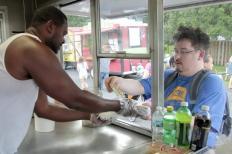






 Eric Gavins and his wife prepare for customers at Raffy's Hot Dog Stand (Kait Vosswinkel/Madison Commons)
Eric Gavins and his wife prepare for customers at Raffy's Hot Dog Stand (Kait Vosswinkel/Madison Commons)
It's feeling like fall in Madison. The wind off Lake Mendota is sharp, and wool scarves are beginning to make an appearance, but the lines outside the food carts on Library Mall and at the capitol building are just as long as ever.
Gary Baker, an employee of JD's, a late-night food cart that caters to crowds on State Street, said he enjoys the work opportunity his job has offered him.
“I love doing this. I see people come here for good food, and I make sure they leave happy,” Baker says.
Food carts have seen a surge in popularity over the past decade. According to IBISWorld, a global industry research firm, street vendors have seen revenues grow by a rate of 3.9 percent since 2008, which is more than double the speed of chain restaurants with brick-and-mortar premises (1.5 percent).
As the food cart trend gains momentum, it's spreading from the coasts towards the Midwest. In Madison, it is rejuvenating a culture of street food that has existed since the 1970's. Gary Baker of JD's serves a customer (Kait Vosswinkel/Madison Commons)
Gary Baker of JD's serves a customer (Kait Vosswinkel/Madison Commons)
Today, food carts are often seen as the new face of American entrepreneurialism, and with a healthy foundation in the art, Madison was quick to build on the movement. Especially in the face of an economic downturn, the trucks are a feasible way to start a business and rapidly see profit.
But, in a notoriously volatile industry like food & beverage, are food carts a viable way to make a future? According to a study by H.G. Parsa, a professor of hospitality management at Ohio State University, restaurant failures sit at around 60 percent within the first three years of operation. Are food carts just another addition to the long line of service industry pitfalls?
Eric Gavins, owner and founder of Raffy's Hot Dogs, believes that food carts are a stepping stone to a more prosperous place in the service industry. For Gavins, starting a food cart was both cheaper and easier than opening a brick-and-mortar restaurant, allowing him to get his business off the ground quickly.
"Of course at the beginning there are ups and downs and you always question certain things, but overall it's definitely been beneficial,” Gavins says.
Gavins celebrated his one-year anniversary business this summer, and is optimistic about the future. The flexibility of his food cart has allowed him to quickly adjust, making changes to his locations, ingredients and pricing that would've been much more costly and time-consuming in a more traditional setting.
"I've had to change menu items and certain things, but it's pretty much coming together,” Gavins says. “It's somewhat challenging at the beginning but once you get rolling with it and you get familiar with it, you get to know who are the right people to talk to. It's alright.”
Gavin’s experience in the food cart industry echoes growing support for the streamlined aspects of the business. Although “lean” business practices may have been started with Gerald Ford and popularized by Toyota, food carts are definitely the most current face of “Lean” in the United States.
Although food trucks are still a substantial investment, ranging from between $50,000 and $150,000, they are still less than half as expensive as a traditional brick-and-mortar restaurant, especially in a city with high property costs.
Food carts, by design, minimize waste and maximize profits. They allow a business owner to quickly respond to changes in the market. Fresh-bought, small batch food can be easily adjusted for fluctuating crowds. Carts can be moved around the city with relative ease, and can adjust their schedules to suit the crowds. This initial success can, in certain cases, lead to long-term success in the community.
Across the nation, especially in large metropolitan areas along the West Coast like Los Angeles and Portland, a new culture surrounding food carts is allowing a migrant community of chefs that are willing to collaborate and experiment with fusion menus to flourish. Twitter feeds and real-time updates about food cart locations are fostering events like San Francisco's SOMA StrEAT Food Park.
Austin Turner, an employee at Madison's Banzo, has worked with the company as they transitioned from food carts to a restaurant on Sherman Avenue. The restaurant is around three years old, and has a successful client base.
"For how young the restaurant is, it's already seeing profit, which is really unheard of. It's about three to four years ahead of what it normally takes for a restaurant to get in the black,” Turner said.
Banzo's food carts are still feeding crowds at Library Mall and on Capitol Square, and are acting as income-generating advertisements in the meantime.
Despite the challenges of harsh winters and short days, the resurgent culture of street food in Madison remains a source of economic growth and diversification, and State Street and the Capitol Square will likely continue to reflect that fact.
“I'll be out there all winter. You'll see me out in the snow,” Baker said. “Like I said, I enjoy doing it. Hopefully...we expand even farther.”
|
|
|
Welcome to the Madison Commons, a website designed to provide news and information about all of Madison's neighborhoods and a crossroads for the discussion of community issues. The name comes from the idea of a village commons, a place for news, talk, debate, and some entertainment, too, that's open to everyone.
All rights reserved. Read more about the Madison Commons and its partners.

